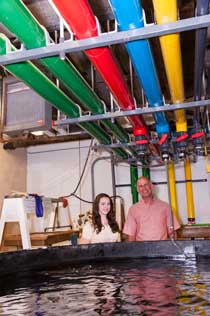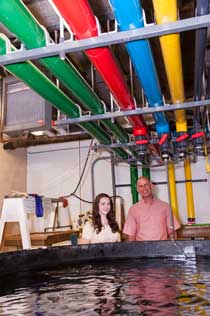 NARRAGANSETT, R.I. – September 25, 2013 — Scientists seeking to study ocean life around the world – or even the seawater itself – are often faced with deciding between the expense of conducting their studies at sea or the complexities of trying to replicate ocean conditions in a laboratory. But thanks to the Marine Science Research Facility at the University of Rhode Island’s Narragansett Bay Campus – and a high-tech and high-powered pumping system — the ocean continuously travels right through campus, making such studies convenient and inexpensive.
NARRAGANSETT, R.I. – September 25, 2013 — Scientists seeking to study ocean life around the world – or even the seawater itself – are often faced with deciding between the expense of conducting their studies at sea or the complexities of trying to replicate ocean conditions in a laboratory. But thanks to the Marine Science Research Facility at the University of Rhode Island’s Narragansett Bay Campus – and a high-tech and high-powered pumping system — the ocean continuously travels right through campus, making such studies convenient and inexpensive.
“We have one of the most versatile seawater facilities in the country,” proclaimed Ed Baker, who manages the facility. “We can manipulate the water to be whatever temperature, salinity or filtration researchers may want. We can chill the water, heat the water, filter out the plankton and other particulates in the water, or leave it unfiltered. We can emulate nearly any marine condition on the planet.”
With 7,000 feet of indoor wet lab space and almost unlimited outdoor space adjacent to the Bay, it is the largest facility of its kind in New England.
Baker said that the facility helps scientists bridge the gap between fieldwork and lab work. “We see the facility as a flexible platform for students and researchers. That flexibility allows us to accommodate a remarkably diverse spectrum of research,” he said.
Scattered throughout the Graduate School of Oceanography’s Aquarium Building – one of several buildings linked to the seawater system — are tanks of various sizes containing sharks, rays, cichlids, snails, algae, sea squirts and assorted other marine organisms. Overhead is a maze of brightly colored coded pipes carrying filtered, heated, chilled and ambient seawater to the tanks. And every day, students and researchers come to feed and care for the marine life or conduct experiments with them.
URI’s shark researchers, for instance, use the laminar flow tank, which Baker describes as “like a wind tunnel with water,” to study the biomechanics of swimming and feeding behavior in bamboo sharks, while aquaculture researchers test alternative feeds for assorted marine fish species. Scientists who recently returned from Antarctica maintain krill and other organisms in polar conditions, while those studying the affect of climate change on invertebrates can keep their samples at whatever temperature Narragansett Bay is on any given day.
“In the marine environment, temperature is fundamentally important, so we have environmental chambers that can control temperature in a very narrow range,” said Danielle Duquette, the assistant manager of the facility. “One degree can be a huge deal; it might mean an entire fish population moves north. Temperature affects metabolism, physiology, reproduction and survival.”
The facility is not just for use by URI scientists and students, however. The Rhode Island Coastal Resources Management Council uses it to study invasive species; Brown University researchers use it to study algae blooms as a proxy for historical temperatures in the bay; scientists at the New Bedford School for Marine Sciences and Technology are conducting a study of how feeding ration affects isotopes in the shells of scallops; and a Rhode Island College professor is studying the effects of toxins on skate development.
The challenge is that the facility is so dependent on its pumps and temperature controls that a power failure can potentially set back some research studies by years.
“Anything that affects our reliability is our enemy,” Baker said. “Power is number one, but adversities include macroalgae that clog our strainers, fouling organisms occluding the pipes, equipment corrosion. It’s sort of like maintaining a ship, but with water going through the ship instead of around it.”
To address these hazards, Baker and Duquette have taken a proactive approach to assure reliability. An alarm system alerts them if any part of the operation fails or if temperatures go out of the target range. The system includes backup generators, redundant equipment, preventative maintenance and round-the-clock emergency response, especially during major storms.
“With the help of faculty member Jennifer Specker, we’ve worked to design a bullet-proof facility,” Baker said. “It gives the researchers the peace of mind that their research is safe and within the conditions that they have set. And it gives them a wide variety of options.”
In addition to the ongoing scientific studies, the facility also hosts numerous visits by school groups throughout the year. These visits can include hands-on science activities, including collecting and testing water samples and examining microscopic organisms through microscopes. Those interested in scheduling a tour should contact Baker at 401-874-6112 or ebaker@gso.uri.edu or Duquette at dduquette@mail.uri.edu.
Pictured above
Danielle Duquette and Ed Baker watch over a tank filled with sharks at the University of Rhode Island’s Marine Science Research Facility. (Photo by Michael Salerno)

